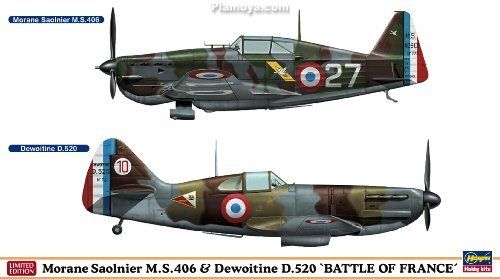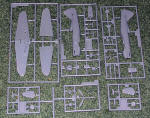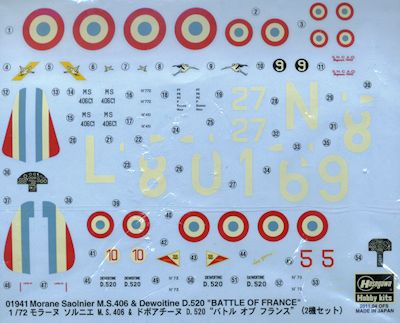
Hasegawa 1/72 MS.406/D.520 'Battle of France'
| KIT #: | 01941 |
| PRICE: | $24.99 on sale (48.00 SRP) |
| DECALS: | Four options |
| REVIEWER: | Scott Van Aken |
| NOTES: | Another Combo kit. 2011 release. |

| HISTORY |
The M.S.406 was a French Armée de l'Air fighter aircraft built by Morane-Saulnier starting in 1938. Numerically it was France's most important fighter during the opening stages of World War II but was under-powered, weakly-armed and lacked full armour protection when compared to its contemporaries. Most critically, it was out-performed by the Messerschmitt Bf 109E during the Battle of France. The M.S.406 held its own in the early stages of the war (the so-called Phony War), but when the war restarted in earnest in 1940, 387 were lost in combat or on the ground (for various reasons) for 183 kills in return. The type was more successful in the hands of Swiss and Finnish air forces who developed indigenous models.
Design of the Dewoitine 520 started in November 1936 at the private design firm led by Emile Dewoitine. Trying to address problems in earlier designs, he created a fighter using only the latest techniques and engines. The new design was to be able to reach 520 km/h and became known as the "520". Only months later the firm was conglomerated into one of a number of design-and-manufacturing pools, in this case SNCAM. Still known as the D.520, work on the design continued at the new company.
The prototype D.520 flew on October 2, 1938, powered by the new 890 hp (660 kW) Hispano-Suiza 12Y-21 liquid-cooled engine. The plane managed to reach only 480 km/h in flight tests, much slower than expected. Most of the problem seemed to come from greater than expected drag from the underwing radiators, so these were merged into a single radiator under the fuselage. After minor damage in a landing accident the engine was changed to a newer -29 and included exhaust ejectors for added thrust, along with an adjustable prop. These changes were enough to allow the plane to reach its design speed.
The prototype was followed in 1939 with two airframes with a new sliding canopy and a larger tail unit. These were armed with a 20 mm cannon firing through the propeller spinner (a feature later found on many German and Russian designs) and two 7.5 mm machine guns in small pods under the wing. The third also included a small tail-wheel instead of the original skid. Flight tests went fairly well and a contract for 200 production machines to be powered by the newer -31 engine (later replaced by the -45) was issued in March of 1939. A contract for an additional 600 planes was issued in June reduced to 510 in July.
With the outbreak of war a new contract brought the total to 1280, with the production rate to be 200 machines per month from May 1940. The Aeronavale then ordered 120. Another Armée de Air order in April 1940 brought the total to 2250 and increased quotas to 350 a month. Needless to say, not all the orders were filled.
The first production D.520 flew in November, powered by the 830 hp (620 kW) 12Y-31 and armed with two 7.5 mm machine guns in housings underneath the wings. It had a curved, one-piece windshield and a sliding canopy. The rest of the production machines were delivered with the 930 hp (690 kW) 12Y-45 engine with a new supercharger and a Ratier 3-bladed propeller (a few had the -49 of 910 hp (680 kW)). They were armed with a Hispano-Suiza 404 20 mm cannon firing through the propeller hub and four MAC 1934 7.5 mm machine guns in the wings. The curved, one-piece windshield from the prototypes was replaced with one containing an optically-flat panel.
| THE KIT |
 Aside
from perhaps a vacuformed or resin kit, the only other kits of the MS.406 aircraft in
1/72 were produced by Frog and later by Heller in the past. Currently RS Models
offers this in their short run line. The Heller kit is not bad, but
when Hasegawa released this one, it pretty well eclipsed both of these kits in
terms of detailing.
Aside
from perhaps a vacuformed or resin kit, the only other kits of the MS.406 aircraft in
1/72 were produced by Frog and later by Heller in the past. Currently RS Models
offers this in their short run line. The Heller kit is not bad, but
when Hasegawa released this one, it pretty well eclipsed both of these kits in
terms of detailing.
The Hasegawa kit is pretty much what we come to expect. Fair, though rather barren cockpit, ejector pin marks on tires, gear struts, seat pan and inside gear doors. A nicely molded one-piece canopy. Crisply molded exterior detailing though some may think the fabric a bit overdone. The retractable radiator is molded in what looks to be the down position. it is nice to see that they got the rather extreme angle of the main wheels correct. Not really a ton of parts, which will appeal to many.
 I've
not built the D.520 kit and in fact, when looking through the stash for one to do,
rarely does my hand stop near it. I'm not sure why, but there it is. This one in
done in the fashion that Hasegawa is known and is a special boxing of a base
kit.
I've
not built the D.520 kit and in fact, when looking through the stash for one to do,
rarely does my hand stop near it. I'm not sure why, but there it is. This one in
done in the fashion that Hasegawa is known and is a special boxing of a base
kit.
As is the norm with Hasegawa 1/72 kits, the interior is adequate for the scale but by no means well detailed. A simple floor, generic looking seat, control stick and instrument panel are provided with a decal for the instruments. A reflector gun sight is provided with its mount. You are offered options with the spinner (one shorter than the other) and in the tail wheel. There is no indication as to which tail wheel is for which markings option.
I found little in the way of flaws, however, there are two large sink areas on each fuselage half opposite some interior bulwarks. These are of a similar size to the sink areas on the Accurate Miniatures Vindicator, yet I don't recall any hue and cry over them. Clear bits (not shown) are well done with the canopy and windscreen molded as one piece with the quarter windows separate.
The set includes two different sets of instructions with a single decal sheet for the two planes. Most folks outside of France know little about either plane, but one thing I like about French planes of this time is that no two camouflage schemes were the same. They all used the same basic colors, but the painters were given pretty free reign on the designs.
 For the
MS.406 the two options are the box art plane from GC III/1 with the other in a
much broader camo scheme from GC I/2. The D.520s both have relatively broad
camouflage schemes as shown on the box art plane from GC I/3. The other is from
the Special Defense Escadrille, all options from May/June 1940. All the paint
references are Gunze and since Gunze does not have any dedicated French colors,
most will need to be mixed. However, Testors does offer these shades as do other
paint companies so finding them should not be a problem. The large decal sheet
is nicely printed though the white looks to be an off white, meaning an 'old
school' sheet. This basically means that most decal solvents will not work
properly so using very hot water with the markings will be the best way to use
them.
For the
MS.406 the two options are the box art plane from GC III/1 with the other in a
much broader camo scheme from GC I/2. The D.520s both have relatively broad
camouflage schemes as shown on the box art plane from GC I/3. The other is from
the Special Defense Escadrille, all options from May/June 1940. All the paint
references are Gunze and since Gunze does not have any dedicated French colors,
most will need to be mixed. However, Testors does offer these shades as do other
paint companies so finding them should not be a problem. The large decal sheet
is nicely printed though the white looks to be an off white, meaning an 'old
school' sheet. This basically means that most decal solvents will not work
properly so using very hot water with the markings will be the best way to use
them.
| CONCLUSIONS |
These sorts of kits are a great way to get some pretty nice kits, especially if you can get them on sale. I dare say I would not pay $24 a kit for these, but $12.50 is another thing all together. Though both of these kits may have been usurped by the more detailed, short run kits by RS Models, if you want a pretty trouble free build, you cannot go wrong with these.
| REFERENCES |
November 2013
Thanks to your editor for getting this on sale.
If you would like your product reviewed fairly and quickly, please contact me or see other details in the Note to Contributors.